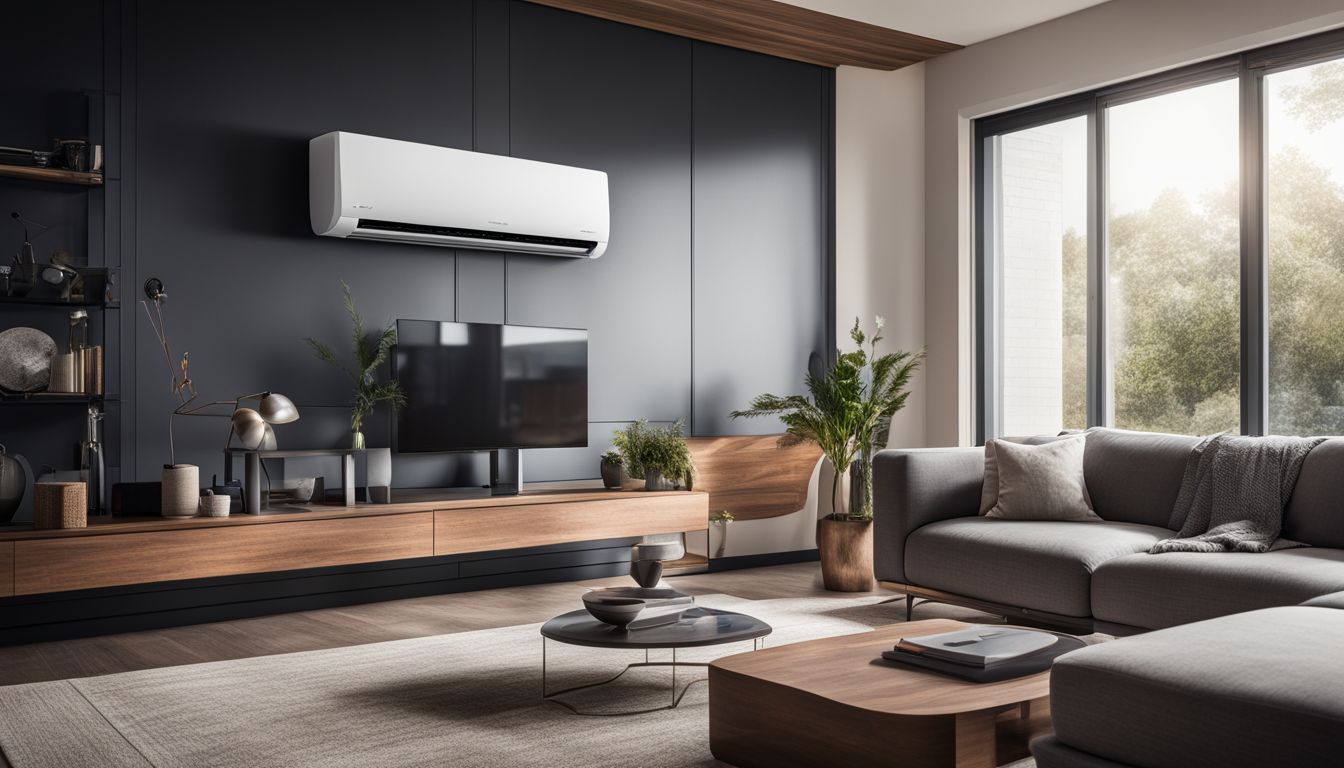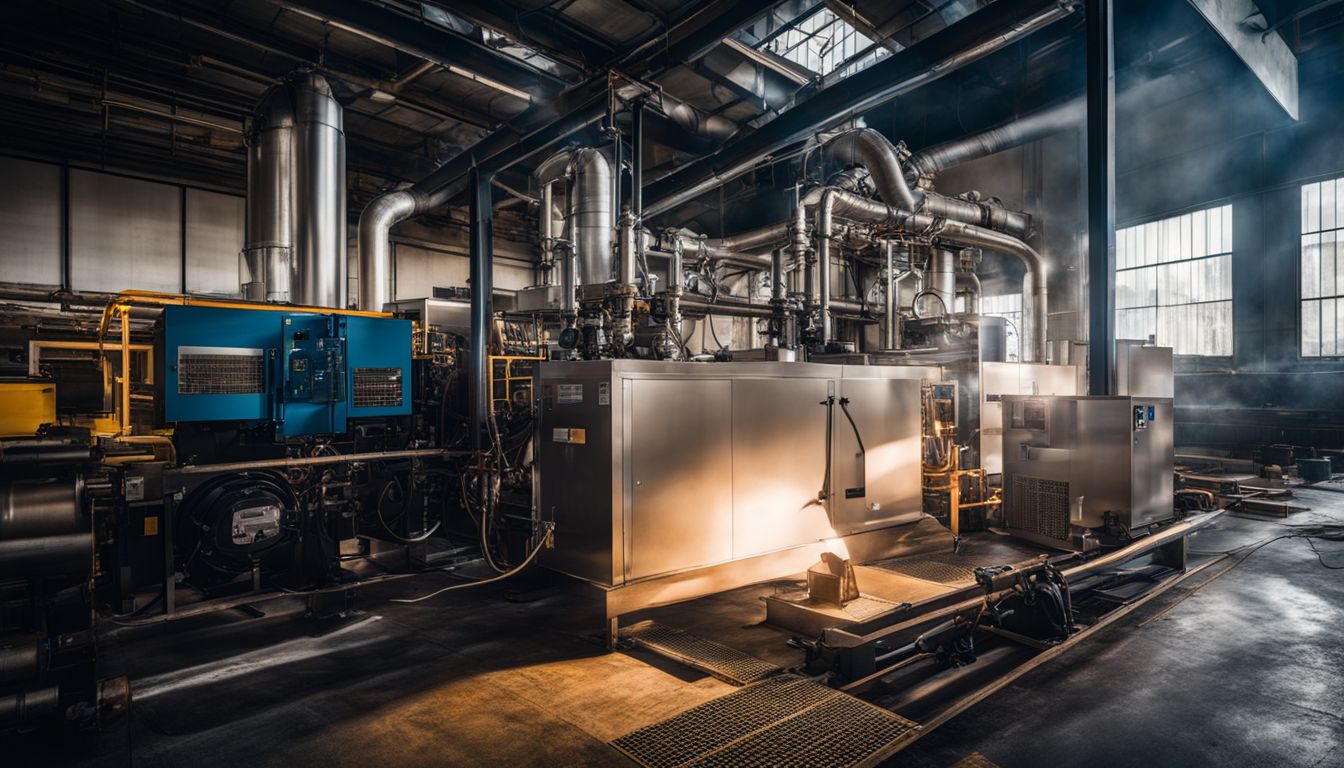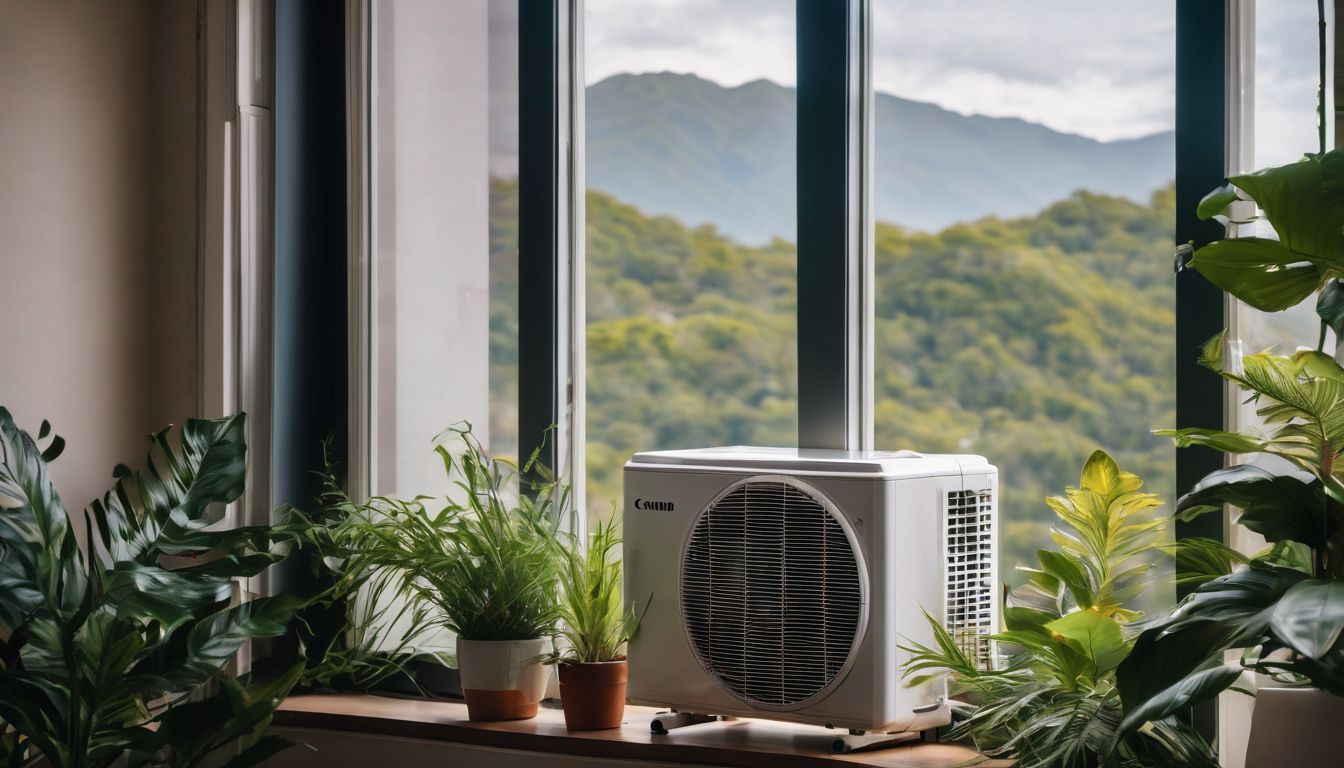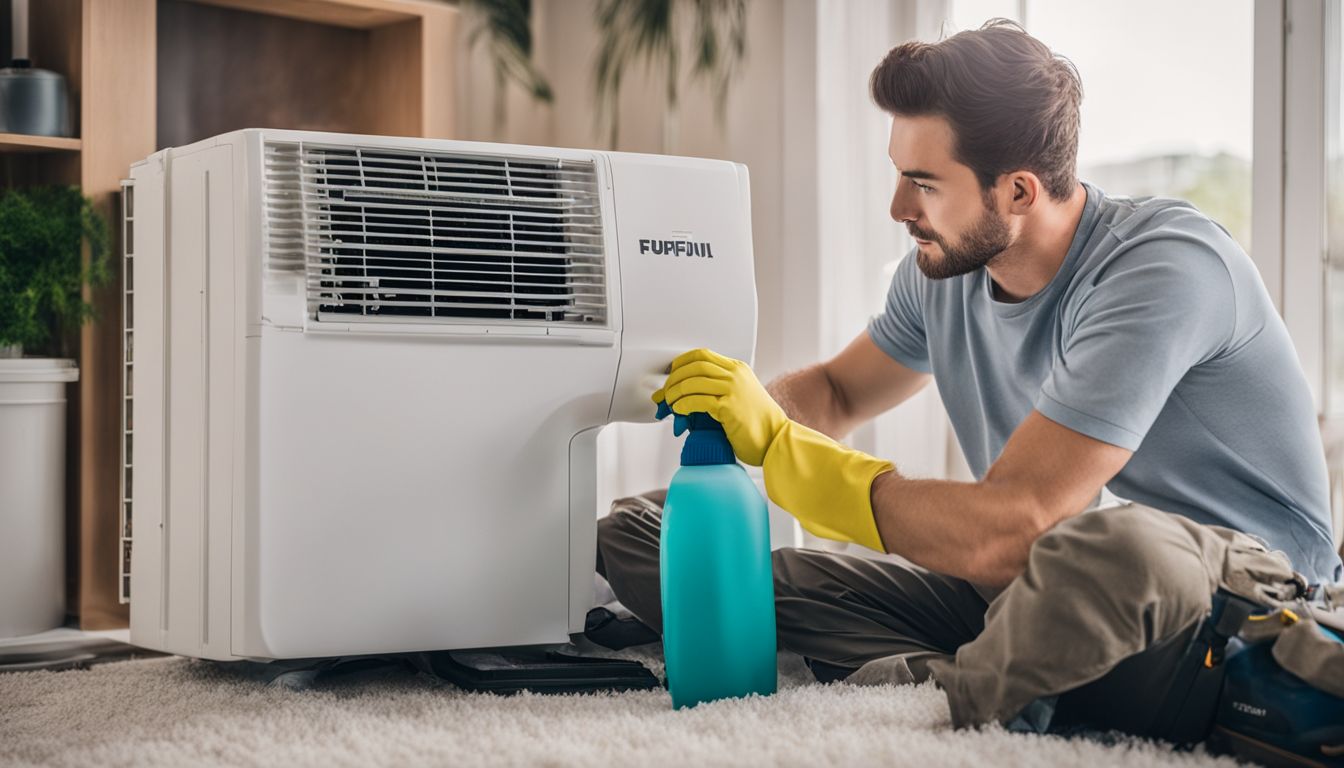Struggling with sticky heat inside your home can be a real discomfort. Did you know that air conditioners do more than chill the air – they also play a crucial role in reducing indoor humidity? This post will explore smart and effective ways to manage humidity levels, helping you create a cooler and more comfortable living space.
Dive in for fresh insights on mastering moisture control!
Understanding Humidity and Its Impact on Air Conditioning
Understanding humidity is fundamental to mastering the dynamics of air conditioning systems, as it directly influences thermal comfort, energy consumption and indoor air quality. The presence and control of moisture in the air play a crucial role in both the efficiency of aircon units and the well-being of occupants within any indoor environment.
Definition of Humidity
Humidity is the amount of water vapour present in the air. It plays a crucial role in determining our comfort levels and has significant impacts on both heating and cooling systems within buildings.
Measured as ‘relative humidity’ (RH), it expresses moisture content as a percentage, indicating how much water vapour the air is holding compared to its maximum capacity at a given temperature.
Controlling this moisture level is essential for maintaining not only comfort but also the integrity of building structures and the healthfulness of indoor environments. Too much humidity can lead to condensation, fostering mould growth and damaging materials; too little can cause dryness, affecting skin and respiratory systems.
Effective humidity control enables HVAC systems to enhance energy efficiency by reducing latent load – the extra effort required by an air conditioning system to dehumidify, which directly affects energy consumption.
Managing indoor relative humidity ensures thermal comfort without unnecessary strain on HVAC equipment or excess energy use.
The Role of Humidity in Air Conditioning
Managing humidity plays a critical role in the performance and efficiency of air conditioning systems. Air conditioners work harder to cool moist air than dry air, making the removal of excess moisture essential for reducing energy consumption and greenhouse gas emissions.
This process not only helps maintain a comfortable indoor climate but also ensures that the system operates optimally. As moisture is continuously extracted from indoor air, the overall humidity levels drop, which directly enhances comfort while promoting energy conservation.
In many climates, achieving the right balance between removing moisture and maintaining desired temperatures can be challenging. Air conditioning units must use energy both to lower the temperature and to decrease vapour pressure by condensing water vapour from humid air.
This dual function increases their workload, especially during peak hot and humid periods. Keeping indoor environments dehumidified prevents overstrain on these systems, enabling them to provide efficient cooling without excessive energy usage or undue wear on components like evaporative coolers or heat exchangers.
The Scientific Approach to Aircon Control

Delving into the scientific approach to aircon control reveals a methodical strategy for maintaining optimal indoor climate conditions. It hinges on precise measurements and innovative technologies that together drive efficiency and comfort in modern living spaces.
Direct Measurement of Indoor Relative Humidity
Measuring the indoor relative humidity is crucial for maintaining a comfortable and efficient air-conditioning system. Technicians use hygrometers or more advanced sensors to determine the percentage of moisture in the air, commonly displayed as % RH.
This data guides adjustments to the aircon system, ensuring it responds accurately to the environment’s actual humidity levels rather than just temperature readings.
The EPCR method relies on this precise data, altering evaporation pressure in sync with changes in both dry-bulb temperature and relative humidity. These tweaks optimise cooling performance and energy usage by tailoring operation conditions.
Collecting information about indoor climate allows researchers to conduct thorough analyses which lead to smarter, more responsive aircon systems that conserve energy while enhancing user comfort.
The EPCR Control Method
The EPCR Control Method stands for Evaporation Pressure Control Ratio, a sophisticated technique that revolutionises the way air conditioning systems regulate temperature and humidity.
It works by continuously monitoring evaporator pressure alongside relative humidity levels. This dual-measurement approach provides more dynamic and precise control of indoor climates, responding in real-time to changing environmental conditions.
Engineers employ this method to achieve better energy efficiency and maintain optimal comfort within spaces. By adjusting the refrigeration cycle based on both pressure readings and moisture content in the air, the EPCR method ensures that air conditioners operate at peak performance without unnecessary energy waste or fluctuations in room temperatures.
Such meticulous control contributes significantly to creating healthy buildings with ideal thermal conditions for occupants.
Advanced Controls for Aircon Systems
Harnessing cutting-edge technology, modern air conditioners are equipped with advanced controls that fine-tune the indoor climate like never before. Real-time optimal control strategies have emerged, allowing variable air volume systems to adapt instantaneously to changes in heating demands.
This innovation not only maintains thermal comfort with precision but also optimises energy consumption for sustainability.
Aircon units today utilise a variety of sophisticated control techniques ranging from classical and hard controls to fusion methods that integrate multiple approaches. Experimental studies support these developments, automating HVAC systems to ensure consistent comfort levels while simultaneously reducing energy usage.
Advanced controls in these systems exhibit the depth of progress in building science and thermodynamics, pushing towards more efficient operations and further minimising our carbon footprint.
Aircon Deconstructed: Understanding Its Different Parts
Air conditioners feature a myriad of components, each essential for proper function and climate control. The compressor is the heart of the system, circulating refrigerant under pressure to absorb heat from inside the room.
It works in tandem with an evaporator coil that extracts moisture and heat from indoor air; this cooling process also assists in humidity regulation. Condenser coils then release absorbed warmth into the outside air while fans distribute cooled air through ducts and vents within a space.
Maintenance plays a crucial role in ensuring these parts operate efficiently. Regular check-ups can identify issues like blocked filters or leaking refrigerant before they compromise air quality or system performance.
Clean filters promote better airflow and prevent dust accumulation on internal components, thus enhancing overall energy efficiency. By understanding these parts and their functions, users can appreciate the sophisticated interplay at work in commonplace cooling systems – where thermodynamics meet mechanical design to create comfortable living environments.
The Importance of a Controlled Environment
Understanding the significance of maintaining a controlled environment is paramount, as it directly influences energy consumption and human comfort, inviting readers to explore how precision in humidity management can revolutionise air conditioning efficiency.
Energy Efficiency Improvements
Efficient humidity control in aircon systems offers more than just comfortable spaces; it’s a gateway to significant energy savings. By managing indoor moisture levels, air conditioners work less strenuously, reducing the electrical resistance faced by their components and cutting down on overall energy consumption.
This is particularly relevant when considering factors that influence Refrigeration, Air Conditioning, and Heat Pump (RACHP) equipment efficiency. Leveraging cloud-based artificial intelligence further optimises these gains by continuously adjusting settings based on real-time data.
Making smart upgrades to your system can also impact energy use. For instance, installing dedicated outdoor air systems (DOAS) can lead directly to enhanced performance and lower electricity bills as they are designed to deal specifically with latent loads, reducing the burden on traditional HVAC units.
Furthermore, integrating technology such as smart thermostats into air conditioning controls ensures precise temperature regulation while minimising unnecessary cooling or heating – leading both to better environmental stewardship and cost-effective operation over time.
Comfort Enhancements
Humidity control plays a pivotal role in providing indoor comfort. Achieving the right balance of moisture in the air ensures that occupants feel neither too dry nor too damp, enhancing overall well-being.
As part of an advanced HVAC system, adjustments can be made to maintain a consistent and pleasant environment that caters to human comfort temperature preferences. This focus on optimal moisture levels reduces skin irritation and respiratory discomfort, making it easier for people to relax or remain productive.
Modern air-conditioning systems employ intelligent controls that adapt to changes in both occupancy and external weather conditions. They sustain a desired level of humidity without constant manual interference, using sensors and controllers that align with ASHRAE standards for indoor environmental quality.
These enhancements not only promote health but also take into account the thermal resistance properties of building materials used, ensuring energy is utilised efficiently while maintaining comfortable living spaces year-round.
The Role of Desiccant-Based Cooling Systems
Desiccant-based cooling systems, pivotal in managing indoor climates, leverage the absorption qualities of desiccants to effectively moderate air moisture levels, offering a compelling alternative for those seeking to optimise their air conditioning efficiency and comfort.
How They Work

Desiccant-based cooling systems tap into the unique properties of materials that naturally absorb moisture from the air. These adsorbents, often silica gel or other specially formulated solids, draw in water vapour through a process of adsorption.
Once saturated, an external heat source is applied to the desiccant material causing it to release the absorbed moisture – this step is known as regeneration.
The cycle continuously alternates between adsorption and regeneration phases, maintaining control over humidity levels effectively. Thermally driven engines power these systems; they integrate seamlessly with additional cooling technologies like evaporative coolers or traditional vapour-compression cycles for precise temperature regulation.
By using thermal energy instead of electrical power for dehumidification, these systems reduce energy consumption and offer a sustainable solution without relying on harmful refrigerants.
Their Benefits in Hot and Humid Climates
Desiccant cooling systems shine in sweltering, sticky conditions. They expertly extract moisture from the air, crucial for comfort and health in tropical settings. This separation of latent and sensible loads ensures the indoor atmosphere is both cool and dry without unnecessary overcooling or subsequent reheating—common issues with standard air conditioning methods.
In regions plagued by high temperatures combined with equally high humidity levels, desiccant systems offer a sustainable solution. Utilising thermal energy for humidity control also means these innovative setups can make significant strides in energy efficiency.
Incorporating evaporative cooling alongside liquid desiccants further optimises climate control within buildings. These approaches serve as practical alternatives to traditional vapour compression cycles, reducing the electrical load while maintaining a controlled environment tailored to hot and humid climates.
The Potential for Energy Savings
Harnessing desiccant-based cooling systems opens the door to significant energy savings in air conditioning, especially in hot and humid climates. These innovative systems, which can slash energy consumption by up to 50%, offer a more efficient way of removing moisture from the air than traditional condensation-based dehumidifiers.
They work tirelessly to maintain optimal indoor conditions while reducing the load on conventional cooling units.
With hybrid desiccant dehumidification air conditioning systems at the forefront of this change, building managers and homeowners stand to benefit from not only reduced energy bills but also enhanced control over indoor humidity levels.
This translates into an environment that’s both comfortable and cost-effective without compromising on performance or sustainability goals. The potential for these technologies to integrate with existing HVAC infrastructure means they could become a standard in future climate control solutions, propelling us towards greener living spaces with lower carbon footprints.
Chilled Ceiling Combined with Desiccant Cooling
In the pursuit of advanced climate control, the integration of chilled ceilings with desiccant cooling systems presents a compelling synergy, leveraging the strengths of radiative temperature regulation and moisture adsorption technologies.
This combination heralds a paradigm shift towards energy-efficient thermal comfort in diverse architectural spaces.
The Use of a Dew-Point Cooling System
A dew-point cooling system takes a clever approach to climate control in buildings, particularly in areas with high humidity levels. It operates based on the principle of cooling air to its dew point, which is the temperature at which air becomes saturated and water vapour begins to condense.
This system pairs well with chilled ceilings, creating an environment where cool surfaces absorb thermal radiation from occupants and objects without causing discomfort from cold air drafts.
Experts propose integrating this technology with desiccant cooling systems for optimal performance in tropical climates. Research indicates that such combinations can significantly cut down energy consumption while maintaining indoor comfort standards.
The setup typically involves using hygroscopic materials that naturally draw moisture from the air; these are then regenerated using thermal energy sources, making the process sustainable and efficient.
Dew-point systems excel by delivering cooled dehumidified air through radiant panels in ceilings—ensuring spaces stay pleasantly dry without overcooking them.
The Future of Humidity Control in Air Conditioning
Exploring the cutting-edge advancements in the realm of humidity control, our journey into air conditioning technology unveils promising solutions designed to revolutionise climate management systems and enhance environmental comfort.
The Use of Solid Desiccant Based Hybrid Air Conditioning Systems
Solid desiccant-based hybrid air conditioning systems harness the unique properties of desiccants to control indoor humidity. These specialised units utilise a material that naturally adsorbs moisture from the air, ensuring optimal relative humidity levels are maintained for comfort and efficiency.
Unlike traditional cooling methods, this innovative approach doesn’t rely on refrigerants that can harm the ozone layer, making it an environmentally responsible choice.
Hybrid systems combine solid desiccant technology with conventional air conditioning components to create more energy-efficient solutions. Desiccant wheels play a crucial role in these setups by capturing moisture before they can affect indoor conditions.
This synergy offers precise humidity control without relying heavily on temperature drops from supply air, which often leads to overcooling spaces just to manage moisture levels. Experimental studies have proven such configurations not only bolster indoor air quality but also contribute significantly to reducing overall energy consumption in buildings.
The Potential for Solar Regenerated Membrane Desiccant Systems
Harnessing the power of the sun to drive humidity control, solar regenerated membrane desiccant systems mark a significant leap towards sustainable air conditioning. These innovative setups use solar energy to regenerate desiccant materials, which effectively remove moisture from the air.
This process can reduce reliance on traditional electricity sources and cut down energy consumption.
In settings where maintaining optimal humidity is crucial, such as hospitals or data centres, these systems offer a revolutionary solution that tackles humidity without imposing a heavy carbon footprint.
They capitalise on thermal energy to manage moisture levels and ensure indoor environments remain comfortable and safe. Solar regenerated membrane desiccant systems are not just an eco-friendly alternative; they represent a smart investment in preserving resources while delivering robust performance in climate control.
Energy-Efficient Predictive Control
Energy-efficient predictive control takes centre stage in the evolution of air conditioning technology. It leverages model predictive control to forecast and adjust temperature setpoints, thereby optimising energy use while maintaining comfort levels.
This innovative approach stands out by considering future conditions and making proactive adjustments, rather than reacting to changes as they happen.
Predictive algorithms analyse a multitude of factors including weather forecasts, building occupancy patterns, and thermal dynamics to calculate the most efficient operation schedule for HVAC systems.
By doing so, these smart systems reduce unnecessary cooling or heating, cut down on energy waste, and lower overall electricity costs. With optimal scheduling of AC setpoints confirmed to diminish energy consumption significantly, implementing such controls could revolutionise the effectiveness of modern climate management in buildings.
Optimal Control Using Genetic Algorithm in VAV Air-Conditioning System
Harnessing genetic algorithms in VAV (Variable Air Volume) air-conditioning systems unlocks the door to unparalleled efficiency and comfort. These intelligent algorithms sift through a multitude of controller settings, evolving them iteratively until they find the most energy-efficient combination for operating the system.
The process mimics natural selection, ensuring that only the best solutions survive and are applied.
Such an approach not only reduces the energy consumption of VAV systems but also enhances their responsiveness to changes in occupancy and thermal loads. This means occupants enjoy consistent temperatures without unnecessary power usage.
Furthermore, by adjusting airflow rates dynamically, genetic algorithm-based controls maintain optimal relative humidity levels, striking a delicate balance between comfort and energy use.
The Impact of Relative Humidity on Indoor Air Quality
Maintaining an optimal level of relative humidity within indoor environments is crucial for enhancing air quality and safeguarding occupant health. Precise regulation of this parameter through advanced HVAC systems mitigates the proliferation of allergens and pathogens, thereby creating a more hygienic and comfortable living space.
Monitoring and Controlling Relative Humidity
Tracking and regulating relative humidity is critical for both comfort and building integrity. Modern air conditioners come with built-in humidifiers or dehumidifiers, ensuring the moisture level indoors is optimal.
These systems help maintain relative humidity below the 60%RH threshold which deters dust mites and other allergens from thriving in our homes.
Employing desiccant dehumidifiers in conjunction with regular HVAC units can significantly reduce indoor moisture levels. This dual approach tackles extreme conditions effectively, protecting furniture and the structure of buildings from moisture-induced damage.
It’s a proactive method of managing the micro-environment within our living spaces, making them safer and more pleasant to inhabit.
Harnessing the Power of Relative Humidity for Optimal HVAC System Performance
Mastering the control of relative humidity is essential for the peak performance of HVAC systems. Precision in balancing moisture levels can drastically improve indoor air quality, fostering a healthier and more comfortable environment.
Humidifiers and dehumidifiers become powerful tools in this quest, fine-tuning the atmosphere to meet precise specifications. They work tirelessly to correct any imbalances, ensuring that air conditioning units operate efficiently and effectively.
Achieving optimal relative humidity not only guarantees comfort but also enhances energy efficiency within buildings. By closely managing humidity levels, HVAC systems avoid overexertion and unnecessary energy consumption.
Such careful regulation minimises heating loads and maximises occupant satisfaction without compromising on cost or ecological sustainability.
Conclusion
In mastering the complexities of humidity control, air conditioning systems transform our living and working spaces. Smart technology now allows for precise adjustments to indoor climates, safeguarding comfort and health.
Implementing these advancements leads to energy savings and sustainable practices in climate management. Expertise in this field continues to evolve, offering innovative solutions for environmental challenges.
These strides in air conditioning ensure that we stay ahead of the curve, creating optimal habitats for both work and leisure.
FAQs
1. What is relative humidity (RH) in the context of air conditioning?
Relative humidity in aircon refers to the amount of moisture in the air compared to the maximum it can hold at a certain temperature, helping control comfort levels and energy storage.
2. How does an air-handling unit manage humidity?
An air-handling unit manages humidity by adjusting the temperature and airflow within a space, often utilising components such as desiccant wheels for moisture removal or humidifiers for adding moisture.
3. Can you explain what dewpoint temperature means for my Aircon system?
Dewpoint temperature is when air reaches a level of saturation and water vapour begins to condense; understanding this helps optimise your Aircon’s cooling performance and prevent excess moisture.
4. What role do optimisation algorithms play in humidity control?
Optimisation algorithms help balance multiple factors like heat capacity, thermal conductivity, and specific heat capacity to achieve efficient humidity control through iterative optimisation processes.
5. Why is radiant cooling important for controlling indoor climate conditions?
Radiant cooling systems provide comfort by absorbing excess heat via convection and radiation without altering the surrounding air temperature significantly, thereby aiding in maintaining appropriate RH levels.
6. How does an adsorption chiller assist with regulating Aircon’s humidity?
Adsorption chillers use a special material that soaks up moisture from the air; this process contributes to reducing excessive dampness while also leveraging thermal energy for effective humidity management.





